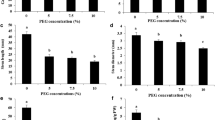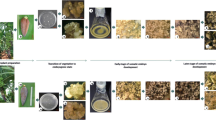Abstract
It is known that protoplasts derived from either leaves or suspension cultures of a citrus genotype vary greatly in their regeneration capacities; however, the underlying physiological mechanisms are not well known. In this study, oxidative stress and antioxidant systems during in vitro culture of callus-derived protoplasts and leaf mesophyll-derived protoplasts of Ponkan (Citrus reticulata Blanco) were analyzed to gain insights into observed physiological differences. Morphological observations using light microscopy and scanning microscopy have shown that new cell wall materials appeared within 2–3 days, and the integrate cell walls were regenerated approximately after 6 days of culture of the callus protoplasts, whereas no cell wall formation was observed in the mesophyll protoplasts after culture. During the culture, higher levels of H2O2 and malondialdehyde were detected in the mesophyll protoplasts as compared with the callus ones. On the contrary, the callus protoplasts possessed higher activities of antioxidant enzymes (SOD, POD and CAT) and larger amount of glutathione and ascorbic acid (at one time point) than the mesophyll protoplasts during the culture process. The current data indicate that the mesophyll and callus protoplasts displayed remarkable difference in the degree of oxidative stress and the antioxidant systems, suggesting that high levels of antioxidant activities might play an important role in the regeneration of protoplasts.





Similar content being viewed by others
Abbreviations
- AsA:
-
Ascorbic acid
- CAT:
-
Catalase
- CFW:
-
Calcofluor White M2R
- CPW:
-
Cell and protoplast washing salts
- EME:
-
Embryogenic callus culture media
- FDA:
-
Fluorescein diacetate
- FESEM:
-
Field emission scanning electron microscopy
- GSH:
-
Reduced glutathione
- MDA:
-
Malondialdehyde
- MT:
-
Murashige and Tucker
- NBT:
-
Nitro blue tetrazolium
- POD:
-
Peroxidase
- ROS:
-
Reactive oxygen species
- SOD:
-
Superoxide dismutase
- TBA:
-
Thiobarbituric acid
References
Bradford MM (1976) A rapid and sensitive method for the quantitation of microgram quantities of protein utilizing the principle of protein–dye binding. Anal Biochem 72:248–254
Butt AD, Bestwick CS (1997) Generation of chemiluminescence during enzymatic isolation of protoplasts from leaves of Oryza sativa. J Plant Physiol 150:729–733
Cutler AJ, Saleem M, Coffey MA, Loewen MK (1989) Role of oxidative stress in cereal protoplast recalcitrance. Plant Cell Tissue Organ Cult 18:113–127
Cutler AJ, Saleem M, Wang H (1991) Cereal protoplast recalcitrance. In Vitro Cell Dev-Pl 27:104–111
Davey MR, Anthony P, Power JB, Lowe KC (2005) Plant protoplasts: status and biotechnological perspectives. Biotechnol Adv 23:131–171
de Jong F, Mathesius U, Imin N, Rolfe BG (2007) A proteome study of the proliferation of cultured Medicago truncatula protoplasts. Proteomics 7:722–736
de Marco A, Roubelakis-Angelakis KA (1996) The complexity of enzymic control of hydrogen peroxide concentration may affect the regeneration potential of plant protoplasts. Plant Physiol 110:137–145
Del Rio D, Stewart AJ, Pellegrini N (2005) A review of recent studies on malondialdehyde as toxic molecule and biological marker of oxidative stress. Nutr Metab Cardiovasc Dis 15:316–328
Farmer EE, Davoine C (2007) Reactive electrophile species. Curr Opin Plant Biol 10:380–386
Galun E (1981) Plant protoplasts as physiological tools. Annu Rev Plant Physiol 32:237–266
Grosser JW, Gmitter FG (1990) Protoplast fusion and citrus improvement. Plant Breed Rev 8:339–374
Grosser JW, Gmitter FG (2005) 2004 SIVB congress symposium proceedings “thinking outside the cell”: applications of somatic hybridization and cybridization in crop improvement, with citrus as a model. In Vitro Cell Dev-pl 41:220–225
Grosser JW, Gmitter FG (2011) Protoplast fusion for production of tetraploids and triploids: applications for scion and rootstock breeding in citrus. Plant Cell Tissue Organ Cult 104:343–357
Grosser JW, Ollitrault P, Olivares-Fuster O (2000) Somatic hybridization in citrus: an effective tool to facilitate variety improvement. In Vitro Cell Dev-pl 36:434–449
Hao YJ, You CX, Deng XX (2002) Cell size as a morphological marker to calculate the mitotic index and ploidy level of citrus callus. Plant Cell Rep 20:1123–1127
Ishii S (1987) Generation of active oxygen species during enzymic isolation of protoplasts from oat leaves. In Vitro Cell Dev-pl 23:653–658
Ishii S (1988) Factors influencing protoplast viability of suspension-cultured rice cells during isolation process. Plant Physiol 88:26–29
Katsirdakis KC, Roubelakis-Angelakis KA (1992) Modified culture conditions for increased viability and cell wall synthesis in grapevine (Vitis vinifera L. cv. Sultanina) leaf protoplasts. Plant Cell, Tissue Organ Cult 28:255–260
Kinnersley AM, Racusen RH, Galston AW (1978) A comparison of regenerated cell walls in tobacco and cereal protoplasts. Planta 139:155–158
Kunitake H, Kagami H, Mii M (1991) Somatic embryogenesis and plant regeneration from protoplasts of ‘Satsuma’ mandarin (Citrus unshiu Marc.). Sci Hortic-Amsterdam 47:27–33
Liu JH, Xu XX, Deng XX (2003) Protoplast isolation, culture and application to genetic improvement of woody plants. J Food Agric Environ 1:112–120
Liu JH, Xu XY, Deng XX (2005) Intergeneric somatic hybridization and its application to crop genetic improvement. Plant Cell Tissue Organ Cult 82:19–44
Mittler R (2002) Oxidative stress, antioxidants and stress tolerance. Trends Plant Sci 7:405–410
Møller IM, Jensen PE, Hansson A (2007) Oxidative modifications to cellular components in plants. Annu Rev Plant Biol 58:459–481
Murashige T, Tucker D (1969) Growth factor requirements of citrus tissue culture. Int Citrus Symp, In, pp 1155–1169
Ohgawara T, Kobayashi S, Ohgawara E, Uchimiya H, Ishii S (1985) Somatic hybrid plants obtained by protoplast fusion between Citrus sinensis and Poncirus trifoliata. Theor Appl Genet 71:1–4
Ondřej V, Kitner M, Doležalová I, Nádvorník P, Navrátilová B, Lebeda A (2009) Chromatin structural rearrangement during dedifferentiation of protoplasts of Cucumis sativus L. Mol Cells 27:443–447
Papadakis AK, Roubelakis-Angelakis KA (1999) The generation of active oxygen species differs in tobacco and grapevine mesophyll protoplasts. Plant Physiol 121:197–206
Papadakis AK, Roubelakis-Angelakis KA (2002) Oxidative stress could be responsible for the recalcitrance of plant protoplasts. Plant Physiol Bioch 40:549–559
Papadakis AK, Roubelakis-Angelakis KA (2005) Polyamines inhibit NADPH oxidase-mediated superoxide generation and putrescine prevents programmed cell death induced by polyamine oxidase-generated hydrogen peroxide. Planta 220:826–837
Papadakis AK, Siminis CI, Roubelakis-Angelakis KA (2001) Reduced activity of antioxidant machinery is correlated with suppression of totipotency in plant protoplasts. Plant Physiol 126:434–444
Papadakis AK, Paschalidis KA, Roubelakis-Angelakis KA (2005) Biosynthesis profile and endogenous titers of polyamines differ in totipotent and recalcitrant plant protoplasts. Physiol Plant 125:10–20
Papadakis AK, Fontes N, Gerós H, Roubelakis-Angelakis KA (2009) Progress in grapevine protoplast technology. In: Roubelakis-Angelakis K (ed) Grapevine molecular physiology & biotechnology. Springer, Netherlands, pp 429–460
Patat-Ochatt EM, Ochatt SJ, Power JB (1988) Plant regeneration from protoplasts of apple rootstocks and scion varieties (Malus × domestica Borkh.). J Plant Physiol 133:460–465
Petřivalský M, Vaníčková P, Ryzí M, Navrátilová B, Piterková J, Sedlářová M, Luhová L (2012) The effects of reactive nitrogen and oxygen species on the regeneration and growth of cucumber cells from isolated protoplasts. Plant Cell, Tissue Organ Cult 108:237–249
Shepard JF, Totten RE (1977) Mesophyll cell protoplasts of potato: isolation, proliferation, and plant regeneration. Plant Physiol 60:313–316
Siminis CI, Kanellis AK, Roubelaki-Angelakis KA (1993) Differences in protein synthesis and peroxidase isoenzymes between recalcitrant and regenerating protoplasts. Physiol Plant 87:263–270
Siminis CI, Kanellis AK, Roubelakis-Angelakis KA (1994) Catalase is differentially expressed in dividing and nondividing protoplasts. Plant Physiol 105:1375–1383
Takebe I, Labib G, Melchers G (1971) Regeneration of whole plants from isolated mesophyll protoplasts of tobacco. Naturwissenschaften 58:318–320
Tan F, Zhang K, Mujahid H, Verma DPS, Peng Z (2011) Differential histone modification and protein expression associated with cell wall removal and regeneration in rice (Oryza sativa). J Proteome Res 10:551–563
Tewari RK, Watanabe D, Watanabe M (2012) Chloroplastic NADPH oxidase-like activity-mediated perpetual hydrogen peroxide generation in the chloroplast induces apoptotic-like death of Brassica napus leaf protoplasts. Planta 235:99–110
Tusa N, Ferrauto G, Galderaro E (1992) Investigation on protoplast regeneration from leaves of monoembryonic and polyembryonic citrus species. In: Proceedings of international society of citriculture, international society of citriculture (ISC), Acireale, Italy, pp 180–182
Wang H, Slater GP, Fowke LC, Saleem M, Cutler AJ (1991) Comparison of cell wall regeneration on maize protoplasts isolated from leaf tissue and suspension cultured cells. In Vitro Cell Dev-pl 27:70–76
Williams L, Zhao J, Morozova N, Li Y, Avivi Y, Grafi G (2003) Chromatin reorganization accompanying cellular dedifferentiation is associated with modifications of histone H3, redistribution of HP1, and activation of E2F-target genes. Dev Dynam 228:113–120
Wiszniewska A, Piwowarczyk B, Pindel A (2012) The influence of isolation stress on the (re)organization of cell walls in protoplasts of in vitro recalcitrant plants. BioTechnology 93:102–108
Xu XX, Liu JH (2009) Study on citrus protoplast culture with a feeder layer composed of UV-irradiated protoplasts. Jiangsu Agric Sci 6:74–75 (in Chinese)
Yasuda K, Watanabe Y, Watanabe M (2007) Generation of intracellular reactive oxygen species during the isolation of Brassica napus leaf protoplasts. Plant Biotechnol 24:361–366
Acknowledgments
This research was financially supported by the National Natural Science Foundation of China, China Postdoctoral Science Foundation (20090451251), the open projects of the National Key Laboratory of Crop Genetic Improvement (ZK201003) and the open funds of Jiangsu Provincial Key Laboratory of Crop Genetics and Physiology (K09002). The authors are grateful to the Testing Center of Yangzhou University for scanning electron microscopy.
Author information
Authors and Affiliations
Corresponding authors
Rights and permissions
About this article
Cite this article
Xu, X., Xie, G., He, L. et al. Differences in oxidative stress, antioxidant systems, and microscopic analysis between regenerating callus-derived protoplasts and recalcitrant leaf mesophyll-derived protoplasts of Citrus reticulata Blanco. Plant Cell Tiss Organ Cult 114, 161–169 (2013). https://doi.org/10.1007/s11240-013-0312-4
Received:
Accepted:
Published:
Issue Date:
DOI: https://doi.org/10.1007/s11240-013-0312-4




